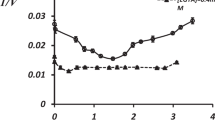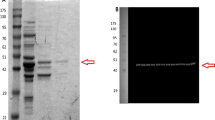Summary
In continuation of the previous report the possible pathways for the incorporation of the precursors nicotinamide or nicotinic acid into NAD of isolated guinea pig atria have been analyzed by combined methods of paper- and column chromatography.
After incubation with a high concentration of 20 mM14C-nicotinamide a deamidation was proved by finding high activities of14C-nicotinic acid in cardiac tissue. An important intermediate,14C-NaAD, could be also detected in a ratio of 1.35∶1 related to the measured14C-NAD. Therefore for the new NAD synthesis thePreiss-Handler pathway is operating. No significant activity was found in NMN and NADP. From a total increase of 24.4 nMol NAD/8 h · 100 mg atrial tissue (+74%) 7.1 nMol can be attributed to a new synthesis of14C-NAD and 17.3 nMol NAD to the inhibition of the degradation. It is assumed that nicotinamide inhibits the NAD degrading glycohydrolase in high concentrations.
After incubation with 20 mM14C-nicotinic acid only a very low14C-incorporation into NAD was observed with thePreiss-Handler pathway. The total NAD level does not change during an incubation time of 24 h.
With a concentration of 10 μM14C-nicotinamide no deamidation to14C-nicotinic acid could be measured in atrial tissue. However, significant activities as14C-NMN,14C-NAD and14C-NADP were observed. Therefore theDietrich pathway is operating here.
With 10 μM14C-nicotinic acid a higher incorporation rate into NAD could be measured than was observed with 10 μM14C-nicotinamide during the same incubation period. The high radioactivity found in NaAD demonstrated that the synthesis proceeds here via thePreiss-Handler cycle. Under these conditions, however,14C-NAD can be degraded easily by the NAD glycohydrolase to14C-nicotinamide and ADPR.14C-nicotinamide was found in atrial tissue as well as in the nutrient solution and can be reincorporated into NAD via NMN in theDietrich pathway, since significant radioactivity was observed in this intermediate.
The analysis of the investigated precursors and intermediates of NAD synthesis and degradation could be established only by the combined methods of paper- and column chromatography, because14C-NaAD can be separated from14C-NAD only with column chromatography and14C-nicotinic acid from14C-NAD only with paper chromatography.
Zusammenfassung
Im Anschluß an die vorhergehende Arbeit wurden in isolierten Herzvorhöfen von Meerschweinchen die möglichen Wege für den Einbau der Precursors Nicotinsäureamid bzw. Nicotinsäure in NAD untersucht. Die radiochemischen und spektrophotometrischen Analysen wurden mit papier- und säulenchromatographischen Methoden durchgeführt.
Nach Inkubation mit hohen14C-Nicotinsäureamidkonzentrationen (20 mM) konnten nach vorausgehender Desamidierung hohe Aktivitäten als14C-Nicotinsäure im Herzvorhof nachgewiesen werden. Außerdem wurde14C-NaAD als wichtige Zwischenstufe in einem Verhältnis von 1.35∶1 zum gemessenen14C-NAD gefunden. Demzufolge wird für diese Neusynthese von NAD derPreiss-Handler-Zyklus beschritten. In NMN und NADP wurden keine signifikanten Aktivitäten gefunden. Bei einer Erhöhung der NAD-Konzentration um 24,4 nMol NAD/100 mg FG (+74%) können 7,1 nMol einer Neusynthese als14C-NAD und 17,3 nMol NAD einer Hemmung des Abbaus zugeordnet werden. In hohen Konzentrationen wirkt Nicotinsäureamid hemmend auf die NAD abbauende Glykohydrolase.
Nach Inkubation mit 20 mM14C-Nicotinsäure wurde über denPreiss-Handler-Syntheseweg nur ein minimaler Einbau in NAD beobachtet. Der NAD-Gehalt zeigte keine Änderung während einer Inkubationszeit von 24 h.
In einer Konzentration von 10 μM zeigte14C-Nicotinsäureamid keine Desamidierung zu Nicotinsäure im Herzvorhof. Es konnten jedoch signifikante Aktivitäten als14C-NMN,14C-NAD und14C-NADP beobachtet werden. Deshalb verläuft die Synthese hier über denDietrich-Weg. Während der gleichen Inkubationsperiode konnte mit 10 μM14C-Nicotinsäure eine höhere Einbaurate in NAD gemessen werden als mit 10 μM14C-Nicotinsäureamid. Die hohe Aktivität, die hier in NaAD gefunden wurde, zeigt an, daß die Synthese über denPreiss-Handler-Zyklus beschritten wird. Unter diesen Bedingungen kann jedoch14C-NAD durch die NAD-Glykohydrolase leicht zu14C-Nicotinsäureamid und ADPR abgebaut werden.14C-Nicotinsäureamid wurde sowohl im Herzvorhof als auch in der Nährlösung gefunden. Es wird über denDietrich-Weg via NMN wieder in NAD eingebaut, was durch die signifikante Aktivität, die in dieser Zwischenstufe gemessen wurde, angezeigt wird.
Eine genaue Analyse der untersuchten Precursors und Zwischenstufen-Nicotinsäureamid, Nicotinsäure, NaAD, NMN, NAD, NADP-ist nur durch eine Kombination von Papier- und Säulenchromatographie möglich, da14C-NaAD nur mit Hilfe der Säulenchromatographie von14C-NAD und14C-Nicotinsäure von14C-NAD nur auf dem Papierchromatogramm getrennt werden kann.
Similar content being viewed by others
References
Colowick, S. P., N. O. Kaplan, M. M. Ciotti: The reaction of pyridine nucleotide with cyanide and its analytical use. J. Biol. Chem.191, 447–459 (1951).
Dietrich, L. S., L. Fuller, I. L. Yero, L. Martinez: Nicotinamide mononucleotide pyrophosphorylase activity in animal tissues. J. Biol. Chem.241, 1, 188–191 (1966).
Dietrich, L. S., O. Muniz, M. Powanda: NAD synthesis in animal tissues. J. Vitaminol.14, 123–129 (1968).
Greenbaum, A. L., S. Pinder: The pathway of biosynthesis of nicotinamideadenine dinucleotide in rat mammary gland. Biochem. J.107, 55–62 (1968).
Grunicke, H., J. Keller, M. Liersch: Effect of nicotinic acid on the intracellular pyridine nucleotide cycle in perfused rat liver. In Metabolic Effects of Nicotinic Acid and its Derivatives. Edited byK. F. Gey, L. A. Carlson 123–131 (Bern 1971).
Grunicke, H., H. J. Keller, M. Liersch, A. Benaguid: New aspects of the mechanism and regulation of pyridine nucleotide metabolism. Advances of Enzyme Regulation12, 397–418 (1974).
Grunicke, H., M. Liersch, M. Hinz, B. Puschendorf, E. Richter, H. Holzer: Die Bedeutung des Nicotinsäureamids für die Synthese des NAD in Ehrlich-Ascites-Tumorzellen. Biochim. Biophys. Acta121, 228–240 (1966).
Hagino, Y., S. J. Lan, C. Y. Ng, L. M. Henderson: Metabolism of pyridinium precursors of pyridine nucleotides in perfused rat liver. Biol. Chem.243, 19, 4980–4986 (1968).
Ijichi, H., A. Ichiyama, O. Hayaishi: Studies on the biosynthesis of nicotinamide adenine dinucleotide. J. Biol. Chem.241, 3701–3707 (1966).
Imsande, J., P. Handler: Biosynthesis of diphosphopyridine nucleotide, III. nicotinic acid mononucleotide pyrophosphorylase. J. Biol. Chem.236, 2, 525–530 (1961).
Kaplan, N. O.: The pyridine coenzymes. In The Enzymes, 3, 105–169P. D. Boyer, H. Lardy, K. Myrback (Eds.), (New York 1960).
Kaplan, N. O., A. Goldin, S. R. Humphreys, M. M. Ciotti, F. E. Stolzenbach: Pyridine nucleotide synthesis in the mouse. J. Biol. Chem.219, 287–298 (1956).
Keller, J., M. Liersch, H. Grunicke: Studies on the biosynthesis of NAD from nicotinamide and on the intracellular pyridine nucleotide cycle in isolated perfused rat liver. Europ. J. Biochem.22, 263–270 (1971).
Klingenberg, M.: In Methoden der enzymatischen Analyse,H. U. Bergmeyer (Weinheim 1975).
Kun, E., P. H. Zimber, A. C. Y. Chang, B. Puschendorf, H. Grunicke: Macromolecular enzymatic product of NAD in liver mitochondria. Proceeding of the National Academy of Sciences (U.S.A.)72, 4, 1436–1440 (1975).
Kunz, W., W. Schmid, M. Siess: Untersuchungen zur Wirkung von 2,6-Bis-(diaethanolamino)-4,8-dipiperidinopyrimido (5,4-d)pyrimidin auf den Herzstoffwechsel. Arzneimittelforschg.12, 1098–1109 (1962).
Langan, T. A., N. O. Kaplan, L. Shuster: Formation of the nicotinic acid analogue of diphosphopyridine nucleotide after nicotinamide administration. J. Biol. Chem.234, 8, 2161–2168 (1959).
Lundquist, R., B. M. Olivera: Pyridine nucleotide metabolism in Escherichia coli. J. Biol. Chem.246, 4, 1107–1116 (1971).
Nishizuka, Y., O. Hayaishi: Studies on the biosynthesis of nicotinamide adenine dinucleotide. J. Biol. Chem.238, 10, 3369–3377 (1963).
Petrack, B., P. Greengard, A. Craston, F. Sheppy: Nicotinamide deamidase from mammalian liver. J. Biol. Chem.240, 1725–1730 (1965).
Pflüger, K. H.: Analytische Methoden zur Extraktion und Trennung der freien Nukleotide von Hefe und ihre Anwendung zur Charakterisierung von Veränderungen des Nukleotidpools bei Zellwachstum und Zellvermehrung. Dissertation, Naturwissenschaftliche Fakultät, Marburg (1975).
Preiss, J., P. Handler: Enzymatic synthesis of nicotinamide mononucleotide. J. Biol. Chem.225, 759–770 (1957).
Preiss, J., P. Handler: Biosynthesis of diphosphopyridine nucleotide. I. Identification of intermediates. J. Biol. Chem.233, 2, 488–492 (1958).
Preiss, J., P. Handler: Biosynthesis of diphosphopyridine nucleotide. II. Enzymatic aspects. J. Biol. Chem.233, 2, 493–500 (1958).
Author information
Authors and Affiliations
Additional information
With 11 figures and 1 table
This study was supported by grants from the “Deutsche Forschungsgemeinschaft”, Bonn-Bad Godesberg, West Germany.
Rights and permissions
About this article
Cite this article
Delabar, U., Siess, M. Synthesis and degradation of NAD in guinea pig cardiac muscle: II. Studies about the different biosynthetic pathways and the corresponding intermediates. Basic Res Cardiol 74, 571–593 (1979). https://doi.org/10.1007/BF01907500
Received:
Issue Date:
DOI: https://doi.org/10.1007/BF01907500




